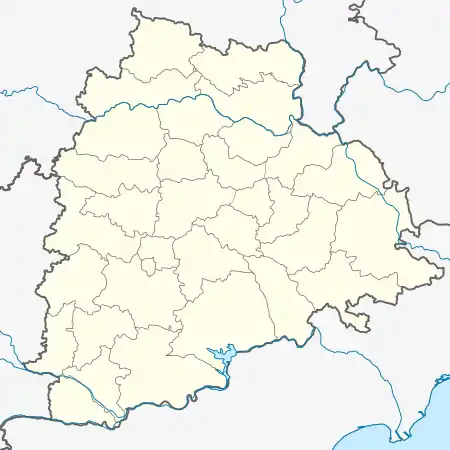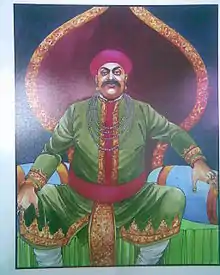Gadwal
Gadwal is a city and the district headquarters of Jogulamba Gadwal district in the Indian state of Telangana.[4] It is located 188 km (117 mi) from the state capital Hyderabad and is a state assembly constituency. Gadwal historically served as the capital of Gadwal Samsthanam, a vassal of the Nizam of Hyderabad. Gadwal was previously a part of the Raichur region of Hyderabad-Karnataka.

Gadwal | |
|---|---|
City | |
 Chennakesava Swamy temple in Gadwal Fort | |
 Gadwal Location in Telangana, India  Gadwal Gadwal (India) | |
| Coordinates: 16.23°N 77.8°E | |
| Country | India |
| State | Telangana |
| Region | Deccan |
| District | Jogulamba Gadwal |
| Founded by | Raja Somanadri |
| Government | |
| • Type | Gadwal municipal council |
| • Body | Telangana Rastra Samithi |
| • MLA | Bandla Krishnamohan Reddy(TRS) |
| • MP | Pothuganti Ramulu(TRS) |
| • Collector & District Magistrate | Shruthi oja IAS |
| • District Superintendent of Police | Ranjan Rathan kumar IPS |
| Area | |
| • Total | 33.46 km2 (12.92 sq mi) |
| Area rank | 1st in erstwile district (Mahaboobnagar) |
| Elevation | 324 m (1,063 ft) |
| Population | |
| • Total | 96,877[3] |
| Languages | |
| • Official | Telugu |
| Time zone | UTC+5.30 (IST) |
| PIN | 509125 |
| Vehicle registration | TS-33 |
| Website | telangana |
Geography
Gadwal has an average elevation of 325 metres (1,066 ft). Gadwal's infrastructure includes a railway junction, river, government-owned land, a sub-collector office, national highway connectivity and brand image in the country.
History

Gadwal developed around a fort built by the Gadwal ruler Somanadri, Gadwal Samsthanam, which was a vassal of the Nizam of Hyderabad. It was protected by Mallichetti vamshiyulu. The Nagi Reddy, known today as Nagappa, was an Ayngarashakulu of Gadwal Samsthanam (Raja Somanadri was a minor). He died in a war with Sultans. Nagappa was succeeded by Narsappa as Gadwal Samsthanam Ayngarashakulu, but had to leave the palace.[5]
Demographics
As of 2001,[6] Gadwal had a population of 53,560. Males constituted 51% of the population and females 49%. 13% of the population was under 6 years of age. As of 2011 this had risen to 63,177[3]
Landmarks
Gadwal Fort is an imposing structure around which the old town sprawls. The fort houses several old temples, the most important of which is Sri Chennakesava Swamy. Another well-known temple, Jammulamma, is located west to the city.
The Priyadarshini Jurala Project is a large dam under construction (as of 2017) near Gadwal. It has almost 62 gates, and its power generation capacity is 234 MW.[7]
Gadwal Saree
Gadwala is known for its handloom Jari chiralu (Gadwala sarees). It was registered as one of the geographical indication from Telangana by Geographical Indications of Goods (Registration and Protection) Act, 1999.[8][9] They are most notable for the Zari on the saris. The sari consists of a cotton body with a silk pallu which called Sico saris. The weave is so light that the saree can be packed in a matchbox.[10] For Lord Venkateshwara Tirumala Tirupati Devasthanam (TTD) Bramhotsavam starts with Gadwala-weaved Pattu Vastralu every year.
Transportation


Rail
Gadwal has a rail junction connecting to other towns and cities, with more than 40 trains passing through daily. The railway station is on Secunderabad–Dhone section. Gadwal became connected by rail to Raichur, Karnataka, after commissioning of the new line on 12 October. Gadwal railway station is planned to become a four-line connecting junction with the addition of a Gadwal–Macherla line. The Railway Department has sufficient land to be used for new railway projects.
Road
Gadwal is located 15 kilometres (9.3 mi) from National Highway 44 (formerly NH-7). A new national highway (Kothakota–Mantralayam) starts from Kothakota then reaches Gadwal, Ieeja, Gudur and Mantralayam. The newly sanctioned Yerravally–Raichur National highway also passes through Gadwal.
Telangana State Road Transport Corporation (TSRTC) runs bus services from Gadwal to major towns and villages.
Solar energy
With the Jurala Project, one of the most prestigious dams in India, 11 km (6.8 mi) away, the town has implemented solar energy for production of electricity.
References
| Wikimedia Commons has media related to Gadwal. |
- "Elevation for Pedakurapadu". Veloroutes. Retrieved 12 August 2014.
- "Census 2011". The Registrar General & Census Commissioner, India. Retrieved 25 July 2014.
- "Cities, Towns and Outgrowth Wards". Citypopulation.de. Retrieved 19 September 2015.
- Gadwal mandal Villages Map
- Gadwal Samthanam in Imperial Gazetteer
- "Census of India 2001: Data from the 2001 Census, including cities, villages and towns (Provisional)". Census Commission of India. Archived from the original on 16 June 2004. Retrieved 1 November 2008.
- "PRIYADARSHINI JURALA PROJECT". krmb.cgg.gov.in. Retrieved 11 September 2017.
- "Geographical Indication". The Hans India. 23 January 2016. Retrieved 27 January 2016.
- "State Wise Registration Details of G.I Applications" (PDF). Geographical Indication Registry. p. 5. Archived from the original (PDF) on 1 February 2016. Retrieved 28 January 2016.
- S, Jayanthi (22 December 2012). "Gorgeous Gadwal". Deccan Herald. Retrieved 2 December 2018.
